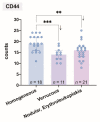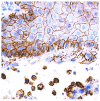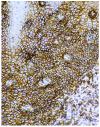Correlation of Soluble CD44 Expression in Saliva and CD44 Protein in Oral Leukoplakia Tissues
- PMID: 34830890
- PMCID: PMC8616328
- DOI: 10.3390/cancers13225739
Correlation of Soluble CD44 Expression in Saliva and CD44 Protein in Oral Leukoplakia Tissues
Abstract
The aim of this study was to determine whether and how pan-CD44 protein expression in leukoplakia tissues correlates with positive SolCD44 test presence and their role in oral leukoplakia. SolCD44 and total protein expression in saliva were determined using an OncAlert® Oral Cancer Rapid test. Comparison of paired associations of total protein, SolCD44, mean number of CD44 expressed epithelial layers in leukoplakia tissue, and macrophages below the basement membrane between control group and patients with leukoplakia showed statistically significant results (p < 0.0001). It is shown that the total protein indicates low or elevated risk of possible malignant transformation processes in leukoplakia. Statistically significant differences between higher total protein level and clinical forms of oral leukoplakia (p < 0.0001), as well as CD44-labeled epithelial cell layer decrease (p < 0.0001), were found. This possibly points to the onset of the stemness loss in leukoplakia tissue. CD9 antigen expression in the exosomes of the oral epithelium explained the intercellular flow of SolCD44 and other fluids in the leukoplakia area. We conclude that the OncAlert® Oral Cancer Rapid test is a valuable screening method in daily clinical practice, in terms of complementing clinical diagnostics methods and to assess the potential for early malignancy.
Keywords: CD44 antigen; exosomes; oral leukoplakia; soluble CD44; total protein.
Conflict of interest statement
The authors declare no conflict of interest.
Figures










Similar articles
-
CD44 and associated markers in oral rinses and tissues from oral and oropharyngeal cancer patients.Oral Oncol. 2020 Jul;106:104720. doi: 10.1016/j.oraloncology.2020.104720. Epub 2020 Apr 20. Oral Oncol. 2020. PMID: 32325304
-
Evaluation of CD44 and TGF-B Expression in Oral Carcinogenesis.J Dent (Shiraz). 2021 Mar;22(1):33-40. doi: 10.30476/DENTJODS.2020.84393.1079. J Dent (Shiraz). 2021. PMID: 33681421 Free PMC article.
-
Comparison of Salivary and Serum Soluble CD44 Levels between Patients with Oral SCC and Healthy Controls.Asian Pac J Cancer Prev. 2018 Nov 29;19(11):3059-3063. doi: 10.31557/APJCP.2018.19.11.3059. Asian Pac J Cancer Prev. 2018. PMID: 30485941 Free PMC article.
-
Oral premalignant lesions: from a clinical perspective.Int J Clin Oncol. 2011 Feb;16(1):5-14. doi: 10.1007/s10147-010-0157-3. Epub 2011 Jan 12. Int J Clin Oncol. 2011. PMID: 21225307 Review.
-
Oral leukoplakia: a clinicopathological review.Oral Oncol. 1997 Sep;33(5):291-301. doi: 10.1016/s1368-8375(97)00002-x. Oral Oncol. 1997. PMID: 9415326 Review.
Cited by
-
Validation of salivary proteomic biomarkers for early detection of oral cancer in the Egyptian population.Future Sci OA. 2025 Dec;11(1):2432222. doi: 10.1080/20565623.2024.2432222. Epub 2024 Dec 6. Future Sci OA. 2025. PMID: 39641414 Free PMC article.
-
Clinicopathological Significance of Cancer Stem Cell Markers (OCT-3/4 and SOX-2) in Oral Submucous Fibrosis and Oral Squamous Cell Carcinoma.Biomedicines. 2023 Mar 28;11(4):1040. doi: 10.3390/biomedicines11041040. Biomedicines. 2023. PMID: 37189658 Free PMC article.
-
CD44 Expression in Oral Lichen Planus and Related Lesions-An Immunohistochemical Study.Indian Dermatol Online J. 2023 Aug 29;14(5):624-629. doi: 10.4103/idoj.idoj_702_22. eCollection 2023 Sep-Oct. Indian Dermatol Online J. 2023. PMID: 37727567 Free PMC article.
-
Diagnostic and therapeutic potential of oral cavity-derived exosomes in oral and maxillofacial tissue engineering: current advances and future perspectives.Naunyn Schmiedebergs Arch Pharmacol. 2025 Jun 10. doi: 10.1007/s00210-025-04316-3. Online ahead of print. Naunyn Schmiedebergs Arch Pharmacol. 2025. PMID: 40490525 Review.
-
High prevalence of CD44 and its ligand low molecular weight hyaluronan in plasma of HNSCC patients: clinical significance.Mol Biol Rep. 2024 Jan 22;51(1):157. doi: 10.1007/s11033-023-08950-z. Mol Biol Rep. 2024. PMID: 38252332
References
-
- Diz P., Meleti M., Diniz-Freitas M., Vescovi P., Warnakulasuriya S., Johnson N.W., Kerr A.R. Oral and pharyngeal cancer in Europe: Incidence, mortality and trends as presented to the Global Oral Cancer Forum. Transl. Res. Oral Oncol. 2017;2:2057178X17701517. doi: 10.1177/2057178X17701517. - DOI
-
- Roza A.L.O.C., Kowalski L.P., William W.N., de Castro G., Chaves A.L.F., Araújo A.L.D., Ribeiro A.C.P., Brandão T.B., Lopes M.A., Vargas P.A., et al. Oral leukoplakia and erythroplakia in young patients: A systematic review. Oral Surg. Oral Med. Oral Pathol. Oral Radiol. 2021;131:73–84. doi: 10.1016/j.oooo.2020.09.002. - DOI - PubMed
LinkOut - more resources
Full Text Sources
Miscellaneous

